A/T/Sub Lt (A) Stanley W. FOOTE
R.N.V.R.
H.M.S. Ark Royal
9 February 1941
On 9 February 1941 the port of Livorno (Leghorn) came under attack from ten Swordfish belonging to the Royal Navy. The Fairey Swordfish is a biplane torpedo bomber, designed by the Fairey Aviation Company. Originating in the early 1930s, the Swordfish, nicknamed "Stringbag", was principally operated by the Fleet Air Arm of the Royal Navy.
The attacks took place at around 0545 and achieved complete surprise. The four Swordfish which were armed with mines dropped them at the ends of the breakwater. Despite the fact that shortly after their arrival an intense AA barrage opened up, it was was inaccurate and no aircraft was lost to AA fire. However, Swordfish 4G, L9773 of 820 Squadron, pilot A/Sub Lt (A) N G Attenborough, crew A/T/Sub Lt (A) S Foote RNVR, and Leading Airman GW Halifax, was lost along with the crew when it hit barrage balloon cables.
The pilot is buried in Staglieno Cemetery, Genoa, but the body of Leading Airman Halifax has never been found and he is remembered on the Lee on Solent Memorial.
From naval-history https://politicaeuropeapress.it/auto-genera-dal-titolo-4/ry.net
121238 Captain John KEANY
Royal Irish Fusiliers/Special Operations Executive
8 March 1945

On the night of 4 February1945, a British plane flew over Mombarcaro in Piedmont with the lights off. The partisans lit fires to indicate their position. Six soldiers belongin to the Chariton Mission parachuted down from the plane. Among the members of the British mission were a South African, Major Adrian Hope, and a very young British volunteer, radio operator William (Bill) Pickering.
After a stay of a few days in Monesiglio, the British moved to Cisterna d'Ast from where a mission under Irish captain John Keany should have got underway.
Bill Pickering tells the story of his war in his book 'I Banditit di Cisterna' . This passage describes the circumstances in which Captain Keany died.
'Captain Keany and I were hidden by a farmer and his wife just outside the village of Monesiglio and only about 400 meters from the German troops ... Every evening after sunset we would go down to the house and set the radio up in the attic, broadcasting messages to our headquarters, based in southern Italy. Many of the neighbours had their homes burned and their men killed for having helped the partisans or the allies, but this in no way dissuaded our hosts from helping us ... After staying overnight with them for a few nights, we began our journey to Cisterna d 'Asti ... after a two hour journey we arrived at a small farmhouse that we had to use for our radio broadcasts.'
Photo Fulvio Vigna
Keany and Pickering were in the middle of a radio conversation with Bari when a partisan friend informed them of the arrival of a group of Germans. They took the transmitter and hid in the nearby orchard, and while the Germans searched the farmhouse they slowly moved away, thinking that the Germans would come out of the house and start looking for them, but this didn't happen.
Sgt. Pickering feared an ambush, saying to the captain:
'"n the last two hours, I have seen about sixty Germans enter that cottage three or four at a time. I haven't seen one come out. In my opinion, they have seen us and are preparing to attack us.''
There was nothing concrete to back up my claim, just a sixth sense telling me we were in mortal danger. I was by nature more pessimistic than the brave Keany, but on this occasion there was an extra intangible ingredient to my distrust. Keany said:
''Don't be silly Bill. They couldn't climb a hill like this without us seeing or hearing them. ''
As far as I remember, those were Keany's last words. I had been standing beside him as we talked, with my radio transmitter in a backpack on my back and my Marlin over my shoulder. For no reason that I could ever explain I suddenly feel scared, vulnerable and exposed. I took two or three steps away from Keany's left flank ... while I did so the Germans opened fire. I threw myself on the ground and saw Keany's chest neatly stitched with a row of bullets. He was thrown back without making any sound, at least no sound that could be heard above the sound of the gunshots.'
A battle ensued. In addition to Captain Keany, four partisans had been killed. The next day Sergeant Pickering returned to the ambush scene:
'I found Keany lying as I last saw him on his back ... We checked for booby traps on Keany and the other partisans, but they were all fine. However, the Germans had emptied their pockets of money or valuables and had taken their weapons. I knew that Keany had 2,500 Italian lire in his backpack - a small fortune in those days. This is to pay for food, ammunition, gasoline, and information. But the money and the manual generator he had brought with him to charge my radio batteries were gone.'
Source:
https://politicaeuropeapress.it/auto-genera-dal-titolo-4/
Private Robert BRUCE (Justo BALERDI)
2 Special Air Service
21 April 1945


Photo: Fulvio Vigna
Justo Balerdi had been born born in Sestao in the Basque Country, Spain but had studied in Barcelona. After having fought against the Francoists in the civil war, he fled to France and joined the Foreign Legion, later he passing to the British Army where in the Algerian desert he assumed the new identity of 'Robert Bruce'. He was parachuted on Cusna on March 4, 1945 with the first group of the 2 S.A.S. under the command of Major Roy Farran.
On 20 March 20, three members of the 2 S.A.S. - Lieutenant James Arthur Riccomini, Corporal Stanley Bolden and Sergeant Sidney Elliott Guscott – were killed during Operation Tombola, an attack on the German headquarters, situated in two buildings in Albinea (provoinice of Reggoio Emilia): Villa Calvi, believed to be the operational centre, and Villa Rossi, thought to be the accommodation of the Corps commander. On 21 April in Torre Maina (Modena) during the second part of the same operation, Justo Balerdi suffered the same fate.
After an initial burial in Albinea all four were buried in Milan, Balerdi, Riccomini and Bolden in the same row.
Fonti: https://ilbraccialedisterline.wordpress.com/2011/06/16/robert-bruce-justo-balerdi/
Crea il tuo sito web con Webador